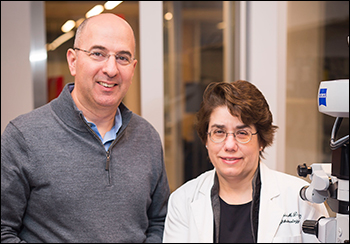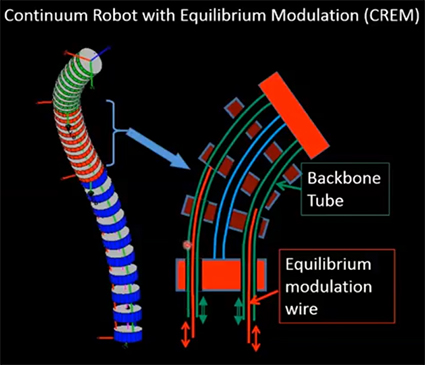Robotic prototype exhibits promise for microsurgery on eyes and aneurysms | Information | College of Engineering
[ad_1]
A brand new continuum robotic designed by Vanderbilt engineers achieves multi-scale movement and will open up an enormous world of beforehand unimaginable complicated microsurgeries.
The robotic is able to offering each a big macro movement workspace as essential for surgical intervention and a small micro motions workspace with movement resolutions of 1 micron or much less. For a way of scale, an inch accommodates 25,400 microns. A human pink blood cell is about eight microns broad, the identical measurement as some micro organism and considerably smaller than the width of the common human hair.
“Our design achieves movement resolutions of 1 micron or much less through the use of cheap actuators. This reconfiguration—with minimal added price—might speed up the event of a brand new class of surgical robots able to each macro-motion for surgical intervention and micro-scale movement for cellular-level imaging or intervention,” mentioned Nabil Simaan, professor of mechanical engineering and director of the Superior Robotics and Mechanism Purposes Laboratory.
“This significantly expands the capabilities of robotics in minimally invasive surgical procedure,” he mentioned.

The miniaturization and vary of movement would enable exact management throughout procedures on complicated aneurysms, tiny veins and arteries, nerves and the fragile constructions of the attention, the inside ear and the vocal cords. Potential functions embody biopsies, tumor eradication and focused drug supply on the mobile stage.
Simaan and his staff have tailored the versatile structure of his earlier continuum robotic to carry out on the macro and micro scale by altering the equilibrium pose of the robotic, which Simaan calls continuum robots with equilibrium modulation, or CREM.
The versatile structure of earlier continuum robots achieved a worm-like movement for macro-manipulation. The robotic is segmented with discs or rings just like the physique of an earthworm. Every disc is joined collectively by tiny backbones, or actuation tubes. By including small elastic wires contained in the actuation tubes and shifting wires up or down, the static equilibrium of the plates adjustments, creating movement on the micrometer scale.
“This new class of robots will present micro-precision whereas traversing macroscale sinuous pathways to the operation web site. Potential advantages embody precise tissue reconstruction and full surgical eradication of tumors,” mentioned Simaan, an affiliate of the Vanderbilt Institute for Surgical procedure and Engineering.

The robotic makes use of tubular secondary backbones to attain the massive scale of movement. By pushing and pulling on them, the continuum robotic configuration adjustments. The addition of wires that may slide out and in of the tubular backbones enabled the analysis staff to modulate the equilibrium form.
Moreover, intensive testing is underway for the incorporation of optical coherence tomography, which is successfully “optical ultrasound” that enables imaging reflections from inside tissue.
Simaan and his colleagues, mechanical engineering graduate scholar Giuseppe Del Giudice, Analysis Assistant Professor of Ophthalmology and Visible Science Jin-Hui Shen and doctor Karen M. Joos, Joseph N. and Barbara H. Ellis Household Professor of Ophthalmology, have completed a preliminary integration of a custom-made OCT probe.
Joos’ specific analysis curiosity is using miniature OCT probes with robotic surgical instruments to enhance visualization for procedures inside the attention. Del Giudice’s experience is in design and management of micro-continuum medical robots, particularly micromanipulation for ophthalmic surgical procedure.
Extending the capabilities of a typical continuum robotic when it comes to micro-scale movement and focusing on might have a deep affect in microsurgery by offering considerably elevated dexterity, controllability and precision to surgeons and even the pioneering of beforehand unimaginable procedures, Simaan mentioned.
The Vanderbilt Heart for Know-how Switch and Commercialization has filed a provisional software for U.S. patent safety on the invention.
This analysis is supported by the Nationwide Science Basis (Grant CMMI 1537659).
Contact: Brenda Ellis, 615 343-6314
brenda.ellis@vanderbilt.edu
Posted on Thursday, November 14, 2019 in continuum robots, continuum robots with equilibrium modulation, CREM, CTTC, micro-motion vary, microsurgeries, Nabil Simaan, NIH,Alumni, Dwelling Options, Mechanical Engineering, Media, Information, Information Sidebar, Analysis
[ad_2]
Supply hyperlink